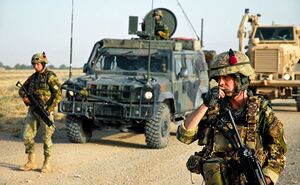Operation Flying Cormorant
| Operation Flying Cormorant | |||||||
|---|---|---|---|---|---|---|---|
| Part of Vegnese Colonialism | |||||||
|
|||||||
| Belligerents | |||||||
| Strength | |||||||
| 10,000 infantry 10 landing ships 15 aircrafts | isolated resistance groups (2,000-3,000 men assumed) | ||||||
Operation Flying Cormorant is a military occupation being conducted by Vegno on the coasts north of Keltia, bordering the Northern Sea. The operation was planned to be a peaceful occupation of these territories; it began in XII.1718 AN and ended in III.1719 AN, with the victory of the Vegnese Armed Forces over the few armed resistance groups of the local populations.
Background
The vegnese poolitic situation prior to this military expedition is certainly particular. Two years ago the great electoral political scandal took place which led to the conviction of the leader of one of the main moderate parties that had dominated the first period of the Vegnese republic, with a consequent sudden drop in support for the traditional parties.
This led to a very rapid rise of extremist parties, both of the extreme right and left, with a clear prevalence, however, of the first one that established themselves as the first force in the country during the elections of 1716. The newly formed government under full extremist leadership of the PNV immediately imposed a clear nationalist and expansionist policy, with a strong strengthening of the military sector and compulsory conscription, with a clear intention of expanding the territories under the influence of Vegno.
Events
Deployment and landing
For the Keltia landing, 10,000 infantry, 15 landing ships, and 15 aircraft were allocated by the Vegnese government. The departure of the infantry forces took place from the ports of Cossa and Sancrus, the most important and largest in Vegno, with the air support shipments leaving a few days after the naval expedition.
The landing took place near the settlement of Vicis, which was immediately peacefully occupied without clashes by the local population and here the outpost in the territory of Keltia of the Vegnese army was established, which immediately renamed the city as vegnian Goffia.

The Battle of Ameri
The first real battle that the Vegnese Army was forced to sustain was the one near the city of Ameri. In fact, in the first days of the advance in the territory, the Vegnese Armed Forces had not met any resistance, on the contrary they were pleasantly welcomed by the local population who were happy to become part of the Vegnese republic. However, the rumors of an advance of the troops quickly spread throughout the territory and this led to the regrouping of part of the population opposed to the Vegnese occupation, above all in the cities of Ameri and Tonsberg, where resistance groups blocked the local population and armed themselves to oppose the Vegnese occupation.
The clash took place in I.1719 AN, at the gates of the city of Ameri, where the armed forces of Vegno routed the approximately 1,500 men present in the local resistance group.
In the initial stages of the battle, the Vegnese troops were taken by surprise by the enemy attack and lost about a hundred units, only to then put themselves back in order and succeed, with few problems, given the clear superiority of both men and means, to conquer and occupy the city. A large part of the population who had been militarily subjugated due to their support for the incoming Vegnese forces was also freed; the city was made safe and renamed in the vegnian Cammarata.
The Battle of Tonsberg and the end of the occupation
The last clash of the military occupation took place in the town of Tonsberg, where the last group of militia resisting the Vegnese Army had gathered. This time the group of militiamen was significantly less numerous and supplied than that of Ameri: in fact, according to the reconstructions of the army, there were between 500 and 1,000 men.
The Vegnese troops quickly routed the opposing forces who, after an initial assault, voluntarily surrendered, noting their clear inferiority in number. The city was therefore easily conquered by the Vegnesi troops who occupied it by hoisting the Cormorant flag, which was welcomed by a large part of the population with happiness, also here as in Ameri, blocked and militarily held by the militiamen.
The end of the operation then happened in a short time in the following weeks, with Nynomarksulda the last city to be occupied and renamed in the vegnian Commanda. The Flying Cormorant operation was officially declared in III.1719 AN, with the vegnesi armed forces which were, however, dislocated in the various cities to ensure public order for the first few years, and then leave it to the local police forces only later.